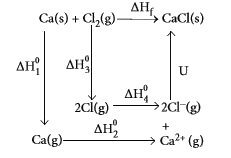Calculate the lattice energy of CaCl2 from the given data
Ca(s)+Cl2(g)→CaCl2(s)ΔH0f=−795 kJ mol−1
Atomisation :Ca(s)→Ca(g) Δ01=+121 kJ mol−1Ionisation :Ca(g)→Ca2+(g)+2e− ΔH02=+2422 kJ mol−1Dissociation :Cl2(g)→2Cl(g) ΔH03=+242.8 kJ mol−1Electron affinity:Cl(g)+e−→Cl−(g) ΔH04=−355 kJ mol−1

ΔHf=ΔH1+ΔH2+ΔH3+2ΔH4+u
−795=121+2422+242.8+(2×−355)+u
−795=2785.8−710+u
−795=2075.8+u
u=−795−2075.8
u=−2870.8 kJ mol−1
Topper's Solved these Questions
- THERMODYNAMICSBOOK - NCERT TAMILCHAPTER - THERMODYNAMICSEXERCISE - EVALUATION (Choose the best answer)
25 Videos
- THE SOLID STATE - IBOOK - NCERT TAMILCHAPTER - THE SOLID STATE - IEXERCISE - QUESTIONS ( Explain briefly on the following : )
6 Videos
- THERMODYNAMICS - IBOOK - NCERT TAMILCHAPTER - THERMODYNAMICS - IEXERCISE - QUESTION
25 Videos
Similar Questions
Calculate enthalpy of formation of methane (CH4) from the following data :
(i) C(s)+O2(g)→CO2(g),ΔrH∘=−393.5KJmol−1
(ii) H2(g)+12O2(g)→H2O(l),DηrH∘=−285.5kJmol−1
(iii) CH4(g)+2O2(g)→CO2(g)+2H2O(l),ΔrH∘=−890.3kJmol−1.
View SolutionCalculate the number of Cl− and Ca2+ ions in 333g anhydrous CaCl2.
View Solution
Knowledge Check
Calculate the number of Cl− and Ca2+ ions in 222g anhydrous CaCl2.
A4N,2NB2N,4NC1N,2ND2N.1N
Calculate the number of Cl− and Ca2+ ions in 222g anhydrous CaCl2.
View SolutionCalculate the number of Cl− and Ca2+ ions in 222g anhydrous CaCl2.
View SolutionCalculate the standard enthalpy of formation of CH3OH(I) from the following data:
CH3OH(I)+3/2O2(g)→CO2(g)+2H2O(I),ΔcHθ=−726kJmol−1
C(g)+O2(g)→CO2(g),ΔfHθ=−393kJmol−1
H2(g)+1/2O2(g)→H2O(I),ΔfHө−286kJmol−1
View SolutionCalculate the standard enthalpy of formation of CH3OH(l) from the following data:
CH3OH(l)+32O2(g)→CO2(g)+2H2O(l),…(i),ΔrHΘ1=−726kJmol−1
C(g)+O2(g)→CO2(g),…(ii),ΔcHΘ2=−393kJmol−1
H2(g)+12O2(g)→H2O(l),...(iii),ΔfHΘ3=−286kJmol−1
View SolutionCalculate the standard enthalpy of formation of CH3OH(l) from the following data:
CH3OH(l)+32O2(g)→CO2(g)+2H2O(l),…(i),ΔrHΘ1=−726kJmol−1
C(g)+O2(g)→CO2(g),…(ii),ΔcHΘ2=−393kJmol−1
H2(g)+12O2(g)→H2O(l),...(iii),ΔfHΘ3=−286kJmol−1
View SolutionCalculate the lattice enthalpy of MgBr2 from the given date:
Mg(s)+Br2(l)→MgBr2(s)ΔfH∘=−524kJmol−1Mg(s)→Mg(g)Δ1H∘=+148kJmol−1Mg(g)→Mg2+(g)+2e−Δ2H∘=+2187kJmol−1Br2(l)→Br2(g)Δ3H∘=+31kJmol−1Br2(g)→2Br(g)Δ4H∘=+193kJmol−12Br(g)+2e−→2Br−(g)Δ5H∘=−662kJmol−1
Strategy : The thermochemical equation corresponding to lattice enthalpy of MgBr2 is
Mg2+(g)+2Br−(g)→MgBr2(s)ΔLatticeH∘=?
Add the last five thermochemical equations to the thermochemical equation corresponding to lattice enthalpy to get the thermochemical equation for the formation of MgBr2(s) from its constituent element. Finally, calculate ΔLaiceH∘, using the concept of Hess's law.
View SolutionCalculate the lattice enthalpy of MgBr2 from the given date:
Mg(s)+Br2(l)→MgBr2(s)ΔfH∘=−524kJmol−1Mg(s)→Mg(s)Δ1H∘=+148kJmol−1Mg(g)→Mg2+(g)+2e−Δ2H∘=+2187kJmol−1Br2(l)→Br2(g)Δ2H∘=+2187kJmol−1Br2(l)→Br2(g)Δ3H∘=+31kJmol−12Br(g)+2e−→2Br(g)Δ5H∘=−662kJmol−1
Strategy : The thermochemical equation corresponding to lattice enthalpy of MgBr2 is
Mg2+(g)+2Br−(g)→Mgr2(s)ΔLatticeH∘=?
Add the last five thermochemical equations to the thermochemical equation corresponding to lattice enthalpy to get the thermochemical equation for the formation of MgBr2(s) from its constituent element. Finally, calculate ΔLaiceH∘, using the concept of Hess's law.
View Solution
